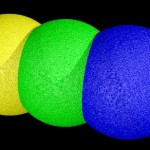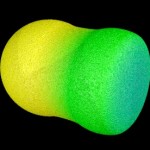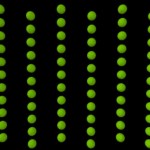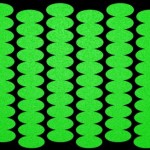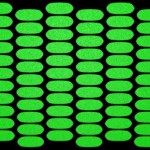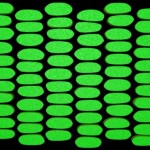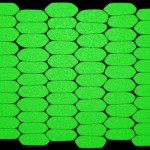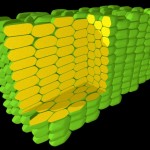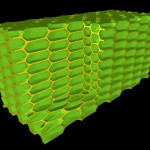When it comes to modeling cellular structures, I have to start talking about some of the features of the program I am using to do so. I am using the ray-tracing program Pov-Ray, which only allows to use geometric structures (including some derivations and combinations) for modeling. So, it is not possible to just sculpt a certain shape as in many other programs. There is a workaround, as it is possible to generate bodies from the gradual addition/subtraction of spheres (and cylinders). I don’t want to go into the theory, therefore I use a simple example to show, how it works: Imagine three identical spheres of different color.
- Blob formation
In this example the yellow and green sphere are fused together, while the blue sphere is subtracted. The object generated by this procedure is called a blob in Pov-Ray.
- Blob formation
Now I will use such blobs to model cellular structures. I first restrict myself to two dimensions for better clarity. First we need the positions of the later cells. Since I want to model somewhat elongated cells, these positions are distributed unevenly.
- Cellular positions
Now the sphere are replaced by blobs generated from a central sphere from which spheres at the positions of the surrounding cells are subtracted. This nicely represents the counterplay of the osmotic pressure of a given cell and the pressure from its surrounding cells in many tissues. As you may see below, by using a similar principal as in nature, we will come to similar results. (That’s what making a model is all about…). Well, for the time being the results do not look that much convincing, but that is only because I chose parameters demonstrating the formation of the blobs. In addition, the blobs are sectioned to have a better view.
With the following parameters (increasing the pressure from the adjacent cells), the cells become more distinguishable.
- Modelling cells
Finally, I add some variation regarding the position of the individual cells …
- Modelling cells
… and increase the “pressure” in all structures.
So far everything was 2D; now let us switch to 3D (which is quite a demanding task at least for my computer…)
- Simple cells
And here is the same structure with empty cells. My solution is not ideal, because, as soon as I try to make thinner cell walls, it becomes increasingly difficult to avoid holes within the walls.

